
Williamsport is a town in Washington County, Maryland, United States. The population was 1,868 at the 2000 census and 2,137 as of 2010.

Georgetown is a historic neighborhood and commercial district in Northwest Washington, D.C., situated along the Potomac River. Founded in 1751 as part of the colonial-era Province of Maryland, Georgetown predated the establishment of Washington, D.C. by 40 years. Georgetown was an independent municipality until 1871 when the United States Congress created a new consolidated government for the entire District of Columbia. A separate act, passed in 1895, repealed Georgetown's remaining local ordinances and renamed Georgetown's streets to conform with those in Washington, D.C.
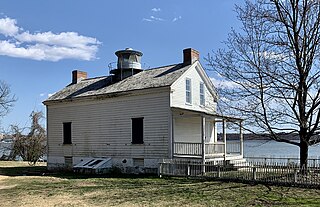
The Jones Point Light is a small river lighthouse located on the Potomac River in Alexandria, Virginia. It was built in 1855.

The Chesapeake and Ohio Canal National Historical Park is located in the District of Columbia and the state of Maryland. The park was established in 1961 as a National Monument by President Dwight D. Eisenhower to preserve the neglected remains of the Chesapeake and Ohio Canal and many of its original structures.
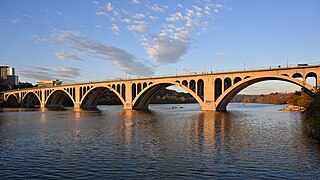
The Francis Scott Key Bridge, more commonly known as the Key Bridge, is a six-lane reinforced concrete arch bridge carrying U.S. Route 29 (US 29) across the Potomac River between the Rosslyn neighborhood of Arlington County, Virginia, and the Georgetown neighborhood of Washington, D.C. Completed in 1923, it is Washington's oldest surviving road bridge across the Potomac River.
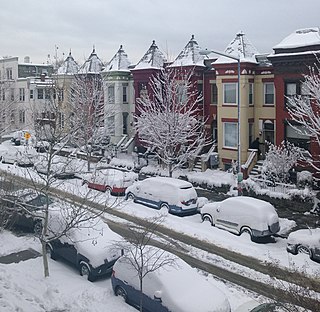
Bloomingdale is a neighborhood in the Northwest quadrant of Washington, D.C., less than two miles (3 km) north of the United States Capitol building. It is a primarily residential neighborhood, with a small commercial center near the intersection of Rhode Island Avenue and First Street NW featuring bars, restaurants, and food markets.

Area codes 202 and 771 are telephone area codes in the North American Numbering Plan (NANP) for Washington, D.C.

Streetcars in Washington, D.C. transported people across the city and region from 1862 until 1962.
The Chesapeake and Potomac Telephone Company, usually known as C&P Telephone, is a former d/b/a name for four Bell Operating Companies providing service to Washington, D.C., Maryland, West Virginia, and Virginia.

Piscataway Park is a National Park Service-protected area located 20 miles (32 km) southwest of downtown Washington, D.C. in and around Accokeek, Maryland. It protects the National Colonial Farm, Marshall Hall, and the Accokeek Creek Site. The park is located across the Potomac River from George Washington's Mount Vernon estate.
The Capital Traction Company was the smaller of the two major street railway companies in Washington, D.C., in the early 20th century.

District of Columbia City Hall, also known as Old City Hall and the District of Columbia Courthouse, is a historic building at Judiciary Square in downtown Washington, D.C. facing Indiana Avenue. Originally built for the offices of the government of the District of Columbia, the District's courthouse was subsequently used as a Federal courthouse, and was the scene of several notable criminal trials including those of three accused presidential assassins. The building was declared a National Historic Landmark in 1960. It now houses the District of Columbia Court of Appeals.

The Bowie Railroad Buildings comprise three small frame structures at the former Bowie train station, located at the junction of what is now the Northeast Corridor and the Pope's Creek Subdivision in the town center of Bowie, Maryland. The complex includes a single-story freight depot, a two-story interlocking tower, and an open passenger shed. The station was served by passenger trains from 1872 until 1989, when it was replaced by Bowie State station nearby. The buildings were restored in 1992 as the Bowie Railroad Museum and added to the National Register of Historic Places in 1998.
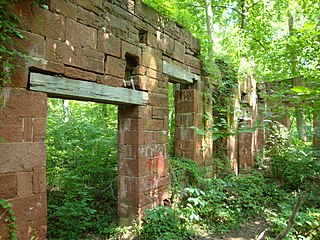
Seneca Quarry is a historic site located at Seneca, Montgomery County, Maryland. It is located along the Chesapeake and Ohio Canal on the north bank of the Potomac River, just west of Seneca Creek. The quarry was the source of stone for two Potomac River canals: the Patowmack Canal on the Virginia side of Great Falls; and the C&O Canal, having supplied red sandstone for the latter for locks 9, 11, 15 - 27, and 30, the accompanying lock houses, and Aqueduct No. 1, better known as Seneca Aqueduct, constructed from 1828 to 1833.

The Southern New England Telephone Company Building is a historic high-rise office building at 55 Trumbull Street in Hartford, Connecticut. It is a twelve-story Art Deco building built in 1931 for the Southern New England Telephone Company, which occupied it into the 1990s. Now mainly residential, it was listed on the National Register of Historic Places in 2004.
Frontier West Virginia, Inc. is one of the original Bell Operating Companies and provides local telephone service in the U.S. state of West Virginia.
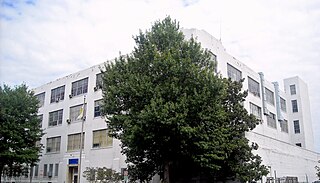
The Chesapeake and Potomac Telephone Company Warehouse and Repair Facility is an Art Deco industrial building, located at 1111 North Capitol Street, Northeast, Washington, D.C., in the NoMa neighborhood which houses the headquarters of National Public Radio.

The Chesapeake and Potomac Telephone Company, Old Main Building is a historic structure located in Downtown Washington, D.C. It was listed on the National Register of Historic Places in 1988.

The Southwestern Bell Telephone Company constructed a two-story building in 1924. The structure, which encompassed 18,726 square feet (1,739.7 m2), was to house the main dial equipment for the new automatic dial equipment that the company had introduced to Tulsa in November 1924. The architecture of the building was Gothic Style. In 1930, the company added four floors to the top of the 1924 structure to house its divisional offices and toll terminal equipment needed for the underground cable that connected Tulsa with Oklahoma City. The 1930 addition was constructed in Zig Zag Art Deco Style.

















